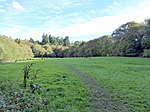Aspidistra (transmitter)

Aspidistra was a British medium wave radio transmitter used for black propaganda and military deception purposes against Nazi Germany during World War II. At times in its history it was the most powerful broadcast transmitter in the world. Its name – after the popular foliage houseplant – was inspired by the 1938 comic song "The Biggest Aspidistra in the World", best known as sung by Gracie Fields. The transmitter was installed in 1942 at a purpose-built site near Crowborough on Ashdown Forest in southeast England. This was equipped with other medium wave and short wave transmitters, which also used the Aspidistra name, being known as ASPI 2, ASPI 3, ASPI 4, etc. However, when the name Aspidistra was used on its own it always referred to the original medium wave transmitter (ASPI 1). The Crowborough station was run during the war by the British government's Political Warfare Executive (PWE). After the war, the station was run by the Diplomatic Wireless Service (DWS) and used for BBC External Service broadcasts to Europe. It closed in 1982.
Excerpt from the Wikipedia article Aspidistra (transmitter) (License: CC BY-SA 3.0, Authors, Images).Aspidistra (transmitter)
B2026, Wealden Maresfield
Geographical coordinates (GPS) Address Nearby Places Show on map
Geographical coordinates (GPS)
| Latitude | Longitude |
|---|---|
| N 51.042694444444 ° | E 0.10420833333333 ° |
Address
B2026
TN22 3JB Wealden, Maresfield
England, United Kingdom
Open on Google Maps









